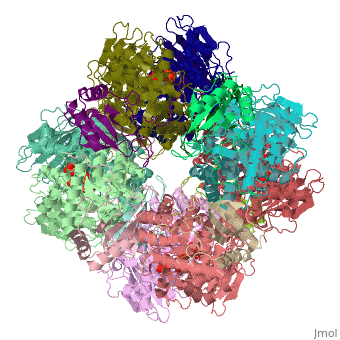Carbon Fixation
From Proteopedia
(Difference between revisions)
| Line 23: | Line 23: | ||
''Step 3'' | ''Step 3'' | ||
| - | The enzyme [[Nathan_Line_sandbox_3|glyceraldehyde-3-phosphate dehydrogenase]] catalyzes the reduction of <scene name='39/392339/Cv1/5'>1,3-bisphosphoglycerate</scene> by NADPH (which is another product of the light-dependent stage). <scene name='39/392339/Cv1/4'>Glyceraldehyde-3-phosphate</scene> (also called G3P, GP, TP, PGAL, GAP) is produced, and the NADPH itself is oxidized and becomes NADP+. Again, two NADPH are utilized per CO2 fixed. This reaction is opposite to that in the [[glycolysis]]. | + | The enzyme [[Nathan_Line_sandbox_3|glyceraldehyde-3-phosphate dehydrogenase]] catalyzes the reduction of <scene name='39/392339/Cv1/5'>1,3-bisphosphoglycerate</scene> by NADPH (which is another product of the light-dependent stage). <scene name='39/392339/Cv1/4'>Glyceraldehyde-3-phosphate</scene> (also called G3P, GP, TP, PGAL, GAP) is produced, and the NADPH itself is oxidized and becomes NADP+. Again, two NADPH are utilized per CO2 fixed. This reaction is opposite to that in the [[glycolysis]]. |
| + | |||
| + | '''The next stage in the Calvin cycle is to regenerate RuBP'''. Five G3P molecules produce three RuBP molecules, using up three molecules of ATP. Since each CO2 molecule produces two G3P molecules, three CO2 molecules produce six G3P molecules, of which five are used to regenerate RuBP, leaving a net gain of one G3P molecule per three CO2 molecules (as would be expected from the number of carbon atoms involved). | ||
</StructureSection> | </StructureSection> | ||
== References == | == References == | ||
<references/> | <references/> | ||
Revision as of 13:12, 1 January 2023
| |||||||||||

